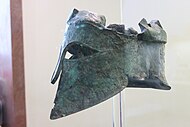Philaidae
The Philaidae or Philaids (
The Philaids claimed descent from the mythological Philaeus, son of Ajax. The family originally came from Brauron in Attica. Later a prominent branch of the clan were based at Lakiadae west of Athens. In the late 7th century BC a Philaid called Agamestor married the daughter of Cypselus, the powerful tyrant of Corinth. In 597 BC a man named Cypselus was archon of Athens. This Cypselus was probably grandson of the Corinthian tyrant of the same name and son of Agamestor.
Some years before 566 BC, a member of the Philaid clan, Hippocleides, was a suitor for the hand of Agariste, the daughter of the influential tyrant of Sicyon, Cleisthenes. However Hippocleides lost out to Megacles from the rival Alcmaeonid clan when Cleisthenes was unimpressed with a drunken Hippocleides who stood on his head and kicked his heels in the air at a banquet.[1]
Tyrants of the Thracian Chersonese
In c.560-556 BC a
Meanwhile a Philaid called Cimon Coalemos, ('coalemos' meaning simpleton), won the prestigious Olympic chariot race three times in succession during the rule of Pisistratid tyrants. He earned a recall from exile by dedicating his second victory to Pisistratus but when he unwisely continued his winning streak by notching up a famous third consecutive Olympic victory he fell foul of Pisistratus' sons Hippias and Hipparchus who had him assassinated.[2]
Around 534 BC Miltiades the Elder died and the tyranny of the Thracian Chersonese passed to his step-brother's son Stesagoras. Then in c.520 BC Stesagoras was succeeded by his brother
Miltiades the Younger also served with King
Miltiades returns to Athens

After Miltiades took part in the failed Ionian Revolt against the Persian Empire he fled the Chersonese and returned to Athens in c.493 BC. He survived a prosecution for tyranny and when the Persians landed at Marathon in 490 BC
Miltiades, as one of ten generals (
Miltiades now enjoyed great prestige at Athens as the victor of Marathon. The following year he was given command of forces which besieged the pro-Persian island of Paros. However the expedition was ill-fated as Miltiades failed to capture the city of Paros and fell off a wall during the siege operations and arrived back in Athens with gangrene in his leg.
The debacle of the Parian expedition led Miltiades' enemies to renew their attacks on him in court and just one year after the victory at Marathon Miltiades the Younger died from his infected leg.
Cimon leads the war against Persia

After the Greek victories over Persia at
Cimon drove the Persians out of the city of
Later Cimon expelled the Persians from the Thracian Chersonese and put down a revolt on Thasos. He was acquitted on a charge of bribery largely through the efforts of his half-sister Elpinice. In c.462 BC Cimon encouraged the Athenians to send military aid to the Spartans who were trying to put down a major revolt by the Helots in the wake of an earthquake which had heavily damaged Sparta. But the conservative Spartans became worried by the revolutionary democratic spirit of the Athenian troops and sent Cimon and his army back home to Athens.
War between Athens and Sparta soon followed this rebuff and Cimon as a prominent pro-Spartan advocate was ostracised from Athens for ten years. He was recalled in 451 BC to lead an Athenian attack against the Persians in
Thucydides
Thucydides, son of Melesias, the leader of the anti-Periclean conservative party during the 440s BC, was a relative of Cimon and a member of the Philaid clan.
